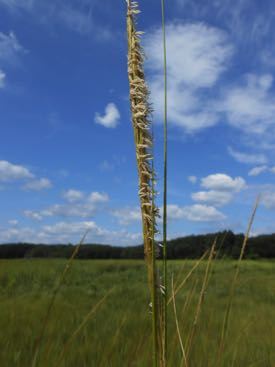
A study recently published in Ecological Applications from the TIDE Project reveals that plants don’t respond to eutrophication the way you might expect. Below is a press release originally posted by the Virginia Institute of Marine Scientists.
***
Add fertilizer to your garden and your plants will probably grow bigger and taller. Add fertilizer to a salt marsh and the plants may not get any bigger. That’s according to a new study led by Dr. David Samuel Johnson of William & Mary’s Virginia Institute of Marine Science.
Salt marshes are intertidal grasslands that grow at the interface between land and sea. These ecosystems can receive excess concentrations of nutrients such as nitrogen from wastewater and runoff of agricultural fertilizer. This “eutrophication” affects coastal waters and estuaries worldwide and can lead to fish kills, harmful algal blooms, and areas of low oxygen. Johnson and his team wanted to know how eutrophication impacted salt marshes.
To do so, the team conducted an unprecedented experiment and flooded football-fields worth of salt marsh in northeastern Massachusetts with fertilizer-rich water for almost a decade. Scott Warren, a professor at Connecticut College and study co-author who has studied salt marshes for four decades, says “When we were able to mimic a eutrophied estuary at an ecosystem scale—quite a challenge I must add—we found that salt marshes did not respond as you might have predicted from fertilization experiments done over the past half a century or so.”
Despite the abundant supply of nitrogen, a key plant nutrient, plants in the fertilized marshes didn’t grow much bigger than those in unfertilized marshes. “We were surprised at the mild responses, even after almost a decade of fertilization,” says Johnson. Earlier salt marsh studies reported plants growing larger in response to adding fertilizer. Previous studies also found that fertilizer changed species composition, causing some species to outcompete others. “The species composition didn’t budge during the entire experiment,” Johnson says.
One reason the team’s results differed from previous studies may be their choice of fertilizer. “We used nitrate fertilizer, which is the most common form of nitrogen in eutrophied estuaries,” says Johnson. “Much of the previous work used ammonium fertilizer. Those studies had different questions than ours; they weren’t specifically looking to understand eutrophication.” Wetland plants prefer ammonium to nitrate because it takes less energy to process, so bigger plants with application of ammonium would not be unexpected.
Another reason the plants may not have responded strongly was the way the fertilizer was delivered—with flooding tidal water, which meant that less fertilizer reached the plants compared to previous studies that had added fertilizer directly to the marsh surface.
The mild response of plants doesn’t mean that salt marshes are safe from eutrophication, however. Johnson notes that when it comes to understanding eutrophication’s impact on salt marshes, the answer may lie beneath the surface. In an earlier paper from the same field study, published in Nature, the research team found that fertilizer treatments caused the marsh edges to collapse and erode away. Again, this is opposite of what they had predicted. “We hypothesized that the grass would grow taller, which would trap more sediment and help the marsh grow,” says Johnson. Instead, they found that plants in fertilized marshes had fewer roots and rhizomes than those in non-fertilized ones, which may have contributed to the collapse.
The team’s research results have important implications for the management and care of salt marshes. These critically important coastal resources are thought to be “nutrient sponges” that soak up excess nitrogen to help prevent dead zones and fish kills. One way they can do so is by putting the nitrogen into bigger plants. Since the plants in the current study didn’t grow bigger, it limited the marsh’s ability to absorb excess nitrogen.
Johnson adds, “Our work underscores that we can’t simply rely on salt marshes to clean up nutrient pollution. We need to do a better job at keeping nutrients out of the water in the first place.”
***
Leave a Reply